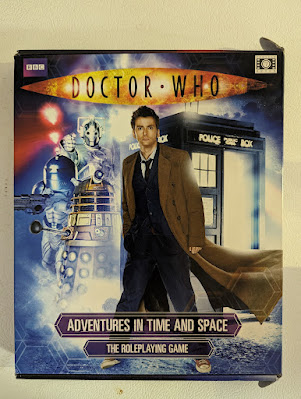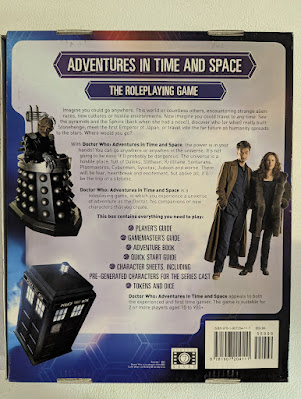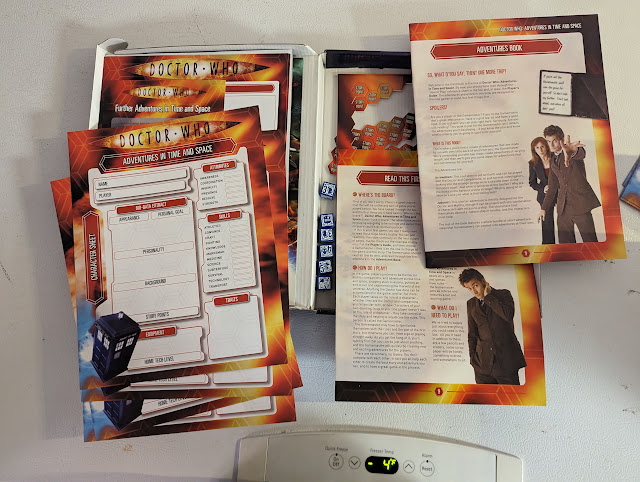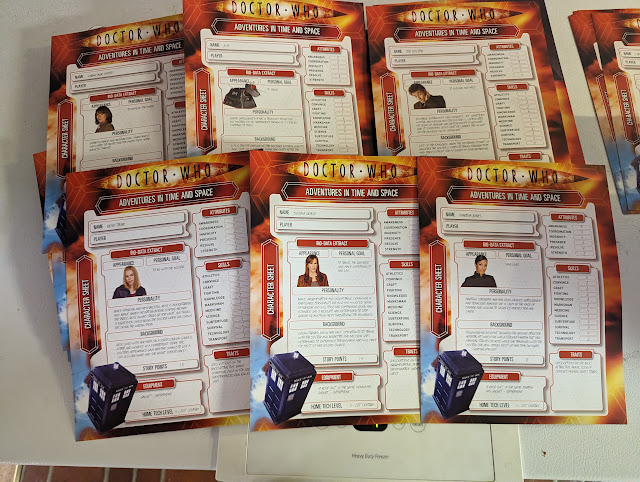A couple of points I want to clarify first.
I am reviewing my boxed set here AND the PDF from DriveThruRPG. There will be differences, so I will point these out.
I was on the playtest for this game as I have mentioned in the past. Plus Dave Chapman and a fe of the Cubicle 7 guys were also play testers for my Ghosts of Albion game. We communicated often in the time Doctor Who, Ghosts, and Chapman's other RPG Conspiracy X was being developed by Eden Studios.
Doctor Who: Adventures in Time and Space
262+ pages. Full-color interior and covers. Print: soft-cover books in a boxed set. Digital: Seven PDFs in a Zip file.
This is the first of many printings of the C7 Doctor Who game. A good way to differentiate from one to the other is by which Doctor appears on the cover. This is the Tenth Doctor's cover.
The Boxed set features two softcover books; a Player's Guide and a Gamemaster's Guide. Several cardboard "story point" tokens, a "Read Me First" booklet, several character sheets, and gadget sheets. All of these are also present in PDF form. The Boxed set additionally has a set of six d6 dice to use in the game. The dice are also available separately.
Read This First - How To Play
This four-page booklet covers the really basic basics. It is written with the Doctor Who fan in mind and not the average role-player. So we cover questions like "where is the board?" and "how do I play?"
Inside the 10th Doctor's character sheet is broken down. It is recommended that starting players use one of the pre-made characters in the box, but there is nothing saying you can't use your own characters.
The "Basic Rule" is covered here.
Attribute + Skill (+Trait) + 2d6 = Result; Compare result to a Task Difficulty.
That is the guiding principle for the entire game and it works really, really well. Your average Difficulty is 12 but it can be as low a 3 (super easy) or 30+ (near impossible). Contested rolls are introduced and the all-important Story Points (the little cardboard counters).
You are directed next to the Adventures Book.
Adventures Book (and Characters)
This is a 32-page book of easy to start with adventures. They include "Arrowdown" with some monster form Autons (very clever), "Judoom" a short adventure inside a Judoon cruiser, and a bunch of adventure seeds to give you some starting points. All the rules needed to run these adventures are self-contained.
For these adventures, it is recommended that you use the provided characters. These include The 10th Doctor, K-9, Sarah Jane Smith, Rose Tyler, Martha Jones, Donna Noble, Mikey Smith, and Capt. Jack Harkness. Additionally, there are some "pre-gens" for players to customize on their own. These include a Medical Doctor, a Musician, a Student, a UNIT Soldier, a Torchwood Operative, a Scientist/Inventor, and a Journalist. There are also six blank character sheets for your own creations. The "named" sheets are printed on slightly heavier stock than the pre-gens or the blank sheets.
There are also gadget sheets, both filled out and blank.
The Player's Guide
These are the rules of the game proper. This is a 86-page soft-cover perfect bound book. Mine is getting on so the binding is coming loose, but nothing that I didn't expect for a book that is nearly 14 years old (which is old for a Sontaran!).
Chapter One: The Trip of a Lifetime
This chapter begins with some set-up fiction. Only two pages. We get another recap on the basics; Who is the Doctor, what is roleplaying, what is a Gamemaster, and the like. As well as how to use this book in the game.
This chapter sets up the game rather well. Imagine going anywhere, anytime, past, present, or future.
Chapter Two: The Children of Time
This covers the characters of the game. From playing your own to games with no Time Lords at all! We start with detailing the Attributes of the character, or the qualities of a character that are typically fixed. These are Awareness, Coordination, Ingenuity, Presence, Resolve, and Strength. Similar to the "Basic 6" of many RPGs. All these are scored from 1 to 6 with 1 being the human minimum, 6 the human maximum, and 3 being the average. Time Lords and other aliens can go beyond these. These are bought on a point-buy system.
Traits are the qualities of a character, good or ill. There are Minor Traits (Animal Friendship, Attractive), Major Traits (Boffin, Fast Healing), and Special Traits (Alien, Cyborg, Time Lord). Like Attributes, you spend Character Points to buy these. Some can be good or bad traits, and some can be Minor, Major or Special depending on how they are "bought" in character creation. "Friends" can be minor or major depending on the friend in question. "Hypnosis" can be minor, major or special depending on how powerful it is.
Skills are also purchased with Points. There are only 12 skills, unlike modern D&D and more like Unisystem, skills can be combined with any attribute as appropriate.
Chapter Three: Allons-y!
This takes us back to our basic rule and expands on it. It gives us some details on the Task Difficulties; 3 for Really, Really Easy, 12 for Average, and 30 for Nearly Impossible. Additionally, there are thresholds if you roll above or below the set difficulty levels. So, for example, if you score 9 points above the roll needed, something special can happen, like extra damage or something. Likewise, if you roll poorly, something bad can happen.
The rolls, much like in Unisystem, become easier with practice, and soon you won't need any guides at all.
Contested rolls, rolls where your character is being prevented from success are also covered. The biggest example of this is combat. Example situations are given and which skills can or should be used. This is a good way to rule these since Doctor Who is not really about combat. "Combat with words" is more important and can even stop physical combat. Though there are weapons detailed here and how deadly they are. Afterall no one can talk a Dalek out of being a Dalek.
Chapter Four: Two Worlds Will Collide
This covers the ins and outs of good Roleplaying. There is also another character sheet here to copy (print) or print out (pdf).
The Gamemaster's Guide
This book is for the Gamemasters naturally. Not that Players can't read it. This book is also a full-color, perfect-bound softcover book. It is 140 pages.
The first four chapters here parallel the four chapters of the Player's book.
Chapter One: Next Stop, Everywhere!
A brief recap of the basics and what this book is for.
Chapter Two: The Stuff of Legend
Covers character creation from a Gamemaster point of view. This includes different types of groups (Doctor and Companions, Unit or Torchwood Groups, and more). We also get some details on how the various Attributes work with examples of seven levels (1-6 for humans, 7+ for others).
Traits are likewise discussed since they provide the most differences between characters and character types. All the traits are covered again, but in briefer, "rules only" formats. Same with skills.
We also get some "Technology Levels" TL. I will have to go back and see how well these map onto other RPGs, in particular the FASA Doctor Who and Traveller. For the record Earth of Doctor Who is TL 5, we are closer to TL 4.75 I think.
Chapter Three: The Long Game
Covers running a game. This includes when to roll (and when not too) and how to judge rolls and difficulty levels. While not a combat-focused game there is lot of text dedicated to it since that is the place where rolls will happen the most.
We get a section on using and regaining Story Points and experience.
Some equipment is also covered here.
Chapter Four: A Big Ball of Timey-Whimey Stuff
Covers not just roleplaying, but roleplaying in Time Travel games. Here we get a lot of advice on how, well, to keep gamers from being gamers and avoiding paradoxes.
We get some background on Time Lords and TARDISes. Not encyclopedic details mind you, but enough to keep players and gamemasters happy.
Chapter Five: All the Strange, Strange Creatures
Ahh. Here is our chapter on all the Aliens. While some are certainly foes to be fought (Daleks, Cybermen) there is a lot here that run the spectrum of friend to fiend. Creatures use the same stats as characters. So it is expected that there are some "Alien Traits" here as well. These work just like Character Traits, but are typically not bought by characters.
Chapter Six: You Are Not Alone
This covers the role of the Gamemaster and what they do in the game. There are some resources shared here for gamemaster including other Doctor Who books out at that time.
Chapter Seven: The Oncoming Storm
This chapter covers running adventures. This includes where (and when) to set them and a basic 5-act adventure formula. Other tips and tricks covered are personal story arcs (thin Donna or Clara), cliffhangers, two (or three) part stories, and more.
It is a great starting point for all GMs.
Doctor Who: Adventures in Time and Space really is a wonderful game and the best Doctor Who game to date. It is easy to see why it has had such staying power. The rules are simple, easy to understand, but infinitely flexible. They emulate the genre very well and can be used to in a variety of situations.
The rule system is such that it could be powering other games as well. It did, for a while, with games like Primeval (no longer available) but I am not sure if it is used elsewhere now.
Honestly, it is one of my favorite games.











No comments:
Post a Comment